One of the great conundrums of recent months is the resilient performance of global equity markets. Quite frankly, not many investors would have bet on this outcome given the severity of the credit crisis which hit us earlier this year. We certainly wouldn't have.
However, many things written on the subject have been poorly researched and/or highly prejudiced and do not stand up to closer scrutiny. One of the exceptions is a brilliant piece of research produced by Citigroup Global Markets about three weeks ago. Their analysts approached the subject by dividing the credit cycle into four phases and analysed the performance of both credit and equity during each stage.
The four stages of the credit cycle
The following is a brief re-cap of the characteristics of each of the four stages in the cycle which we have taken directly from the research paper:
MoneyWeek
Subscribe to MoneyWeek today and get your first six magazine issues absolutely FREE

Sign up to Money Morning
Don't miss the latest investment and personal finances news, market analysis, plus money-saving tips with our free twice-daily newsletter
Don't miss the latest investment and personal finances news, market analysis, plus money-saving tips with our free twice-daily newsletter
"This phase immediately follows the bottom of the credit bear market. Spreads fall sharply as companies repair balance sheets, often through deeply discounted share issues (as we saw for Insurance and Telecom companies back in 2002-03). This, along with continued pressure on profits, keeps equity prices falling.
"The next phase begins as profitability turns and equity prices start to rally. Credit spreads fall even further as corporate cash flow rises strongly. We call this an immature equity bull market. For the present cycle, this phase began in March 2003.
"The credit bull market is over; spreads start to rise as investor appetite for leverage wanes. The equity market decouples from credit and continues to rise. We think that the market is entering this phase now. This is the mature equity bull market.
"This is the classic bear market, when equity and credit prices are falling together. It is usually associated with falling profits and worsening balance sheets. Insolvencies plague the credit market; profit warnings plague the equity market. A defensive strategy is most appropriate cash and government bonds are the best performing asset classes."
Chart 1 below summarises Citigroup's findings.
Chart 1: Credit/Equity Cycle
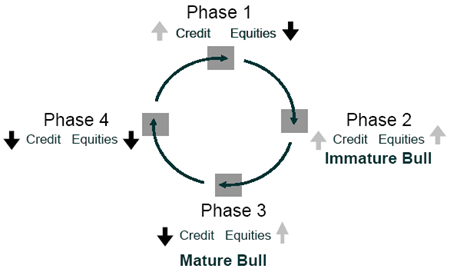
Source: Citigroup Investment Research
Now, it is their contention that we have recently entered the third phase of the cycle, the mature bull market. This happened on the 12th June this year when credit spreads bottomed. The mature bull market is characterised by rising credit spreads. As you can see from chart 2 below, in the last twenty years, we have been through two similar experiences in 1988-90 and again in 1997-00. In both instances, credit spreads widened by approximately 300 basis points. Almost five months into the current cycle, spreads have widened by approximately 120 basis points.
Chart 2: US High Yield Spreads during the Credit Cycle
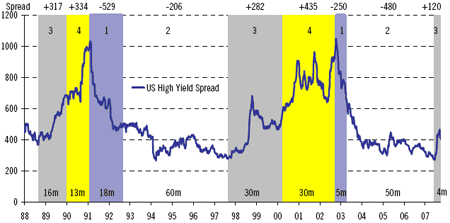
Source: Citigroup Investment Research
If we instead turn our attention to equities and see how they have performed during the same four credit stages, we note that they usually continue to deliver robust returns during phase 3 despite the deterioration of the credit environment (see chart 3 below). 1988-90 and 1997-00 are both evidence of this. Again, the Citigroup analysts make the point that it is during phase 3 (the mature bull market) that bubbles are created and that it is ultimately the bursting of those bubbles which ends the bull market and brings us to the end of the cycle.
Chart 3: Global Equity Prices during the Credit Cycle
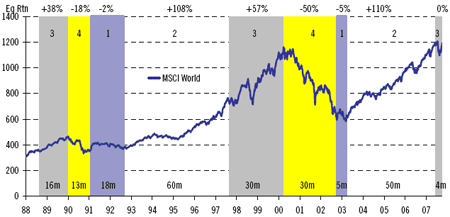
Source: Citigroup Investment Research
Obviously, what the Citigroup research paper doesn't tell its readers is how long the mature bull can go on before it runs out of steam. As you can see from chart 3, the 1989-90 mature bull market lasted 16 months whereas the 1997-00 bull ran for 30 months before it all ended in tears. One possible way to assess the sustainability of the equity bull market is to measure the ongoing deterioration of credit quality. Merrill Lynch has created an index the so-called High Yield Distress ratio which measures the number of bond issues which trade in excess of 1000 basis points over Treasuries (see chart 4 below).
Chart 4: Merrill Lynch Distress Ratio
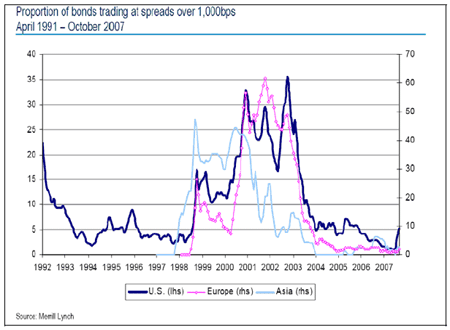
Source: The HCM Market Letter, Merrill Lynch
Merrill Lynch measures deteriorating credit quality in the US, Europe and Asia and, as is evident from chart 4 above, there are already signs of decline, although the weakening trend has been limited to the US market so far. We wouldn't suggest that the chart above sets off any immediate alarm bells but, quite clearly, the situation is deteriorating and must be monitored.
Moving swiftly from corporate credit to mortgage backed securities, there are now signs that the recent sub-prime crisis is spreading into higher quality loans. A little known index called the ABX.HE index, which is a synthetic yet tradable index of US mortgage backed securities, has behaved quite extraordinarily in recent weeks. As you can see from chart 5 below, when the Federal Reserve Bank cut rates on the 20th September by 50 basis points, the ABX.HE AA index traded at about 86.
Chart 5: AA-Rated US Mortgage Backed Securities (ABX)
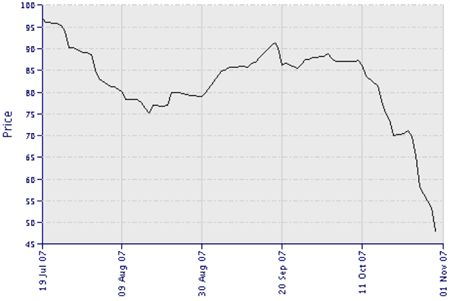
Source: Markit Group Limited
As we all know now, the Fed's action had the instant effect of calming the markets which have behaved relatively well since then. However, the recent performance of the ABX index suggests that something is not quite right. Any market where AA-rated paper is cut in half in a matter of weeks is sick, whatever the underlying reasons. It has been suggested to us that technical factors are behind the collapse as the ABX index is one of the few ways to hedge your exposure to mortgage backed securities. However, the mere fact that someone out there, who happily bought the index at 97 in mid July, is now prepared to sell it at 48 suggests to us that we haven't seen the last of this crisis.
Also, a good friend of the firm pointed out to us the other day that investors seem to have forgotten that only about one quarter of all sub-prime paper is to be found on banks' balance sheets. The majority is actually sitting in the portfolios of insurance companies, pension funds, endowment funds and other institutional investors most of whom are not publicly traded companies and therefore do not have the same urgent pressure on them to share their bad investment decisions with the rest of us, as they do not report quarterly. That will all change when the annual accounts are due early next year. Partly for this reason, it is our conviction that we are still only in the second or third inning of a drawn-out and rather painful crisis.
Before I wrap up this month's letter, I cannot resist making a brief comment on oil prices which are just a notch below $96 per barrel (WTI that is) as these lines are written. What many investors do not seem to realise is that the recent credit crisis and the ongoing bull market in energy prices is a product of the same phenomenon. As interest rates have traded lower and lower in recent years, investors have applied increasingly desperate tactics to squeeze out whatever returns could be squeezed out of a low return environment. As banks were only too willing to lend, investors loaded up on ever riskier products. And do not kid yourself. This game was never reserved exclusively for hedge funds. Private investors, insurance companies, even your local pension fund, have been every bit as guilty of jumping on the bandwagon. When money is cheap, stupid decisions are made and accidents ultimately happen, and that is indeed what occurred earlier this year.
Now, what has that got to do with energy prices I can hear you ask. Nothing, apart from the fact that the very same investors who got greedy and forgot to apply some common sense to credit risk are possibly making the very same mistakes in today's commodity markets. Trading commodities used to be a simple game. Commodity producers would have a natural reason to short in order to hedge their anticipated revenue flow whereas speculators typically provided the other side of that trade. Everyone was happy. Liquidity was limited but sufficient to meet the demands of commodity producers.
Along came a bunch of smarties' with fancy computer models (including ourselves, I reluctantly admit) telling whoever cared to listen that commodities belong in a diversified portfolio. Fortunately for everyone, the Asian growth miracle unfolded at the same time, providing a fundamental alibi for the argument.
The rest is history, with everyone off to the races and oil prices going from $35 per barrel in March 2004, when we first predicted $100 oil prices, to almost $96 as of this morning. The reality is that oil prices are becoming increasingly disconnected from economic fundamentals. The global economy is cooling off, oil inventories are booming and oil refineries have more spare refining capacity than has been the case for years. We hear stories from Rotterdam harbour that oil tankers have to wait a week or longer to offload their cargo. Apparently, you can cross Rotterdam harbour these days by walking from tanker to tanker. The world is quite simply awash in oil. So why $96 per barrel?
This is the tricky part. I have no hard evidence of what I am going to say next but I am becoming increasingly convinced that oil markets are manipulated. Oil producers enjoy life in the fast lane and the freedom and power which follows with the many extra billions of dollars stacked away in their bank accounts. Iran needs the money to pursue their aggressive foreign policy. So does Russia. Hedge funds, meanwhile, have discovered to their delight that commodity prices are much easier to move than equity or bond prices so they are happy to play ball.
This has created a situation where financial investors have completely overwhelmed commodity markets. There is quite simply too much money chasing a market which is strictly limited in size. As always, when liquidity drives the equation, it is bound to end in tears.
We believe it is time to exit the corporate high yield market if you haven't already done so. Given the extent of the current credit crisis it is difficult to see how we can escape an expansion of credit spreads at least in line with historic averages, which suggests that there is a great deal more downside risk to corporate high yield bond prices.
The outlook for equity markets is less straightforward. History suggests that the current bull market could run for a bit longer to be more precise, for as long as corporate earnings hold up and corporate credit quality doesn't collapse. Despite the unsettled nature of the markets over the last few days as a result of first Merrill Lynch's problems and now Citibank's, we have a relatively high level of conviction that equity markets will do reasonably well until at least Christmas time and possibly also early in the new year (this relatively optimistic short term outlook does not include financial stocks which are likely to continue to suffer from problems in the industry). As we look further into 2008, the picture we see is increasingly murky, and we would be sellers on strength between now and then. As we have said repeatedly, the credit debacle is going to get a great deal worse before we can confidently declare the crisis to be over and, sooner or later, this realization will start to do serious damage to equity markets.
In the meantime, and knowing that credit is becoming ever more tight, you want to invest where liquidity is ample. Quite interestingly, and unlike anything we have witnessed before, liquidity in today's market is to be found in the Middle East (oil), Russia (oil), China (high savings) as well as in a number of other emerging markets. This offers a new and quite unique set of dynamics and investors cannot necessarily assume that large and established markets such as the US, UK and Germany will offer the best protection against more difficult equity market conditions. Historically, emerging markets have taken the brunt of the pain in liquidity driven sell-offs, but that was due to the fact that these economies ran into liquidity problems. With emerging markets now providing liquidity to the rest of the world, we are suddenly not so sure who will be the winners and who will not.
Finally, as far as commodity markets are concerned, don't listen to the bulls who suggest that this time things are different. Commodity prices are due a major correction, with or without the Chinese miracle, and the correction is likely to pull the chair away underneath you sometime during 2008.
John Bird and John Fortune, two outstanding British actors and comedians, have made a hilarious contribution to the debate surrounding the current credit crisis. You can watch them in action on YouTube.
If you enjoy this half as much as we did, you are in for a good laugh.
By Niels C. Jensen, chief executive partner at Absolute Return Partners LLP. To contact Niels, email: njensen@arpllp.com
Get the latest financial news, insights and expert analysis from our award-winning MoneyWeek team, to help you understand what really matters when it comes to your finances.
MoneyWeek is written by a team of experienced and award-winning journalists, plus expert columnists. As well as daily digital news and features, MoneyWeek also publishes a weekly magazine, covering investing and personal finance. From share tips, pensions, gold to practical investment tips - we provide a round-up to help you make money and keep it.
-
 How cancelling unused direct debits could boost your pension by £37,000
How cancelling unused direct debits could boost your pension by £37,000A new year refresh of your spending could save you money and help boost your pension pot.
-
 NS&I cuts interest rates on 8 savings accounts
NS&I cuts interest rates on 8 savings accountsNS&I will now offer less attractive interest rates for customers wishing to lock their savings away to grow for one, two, three or five years.

